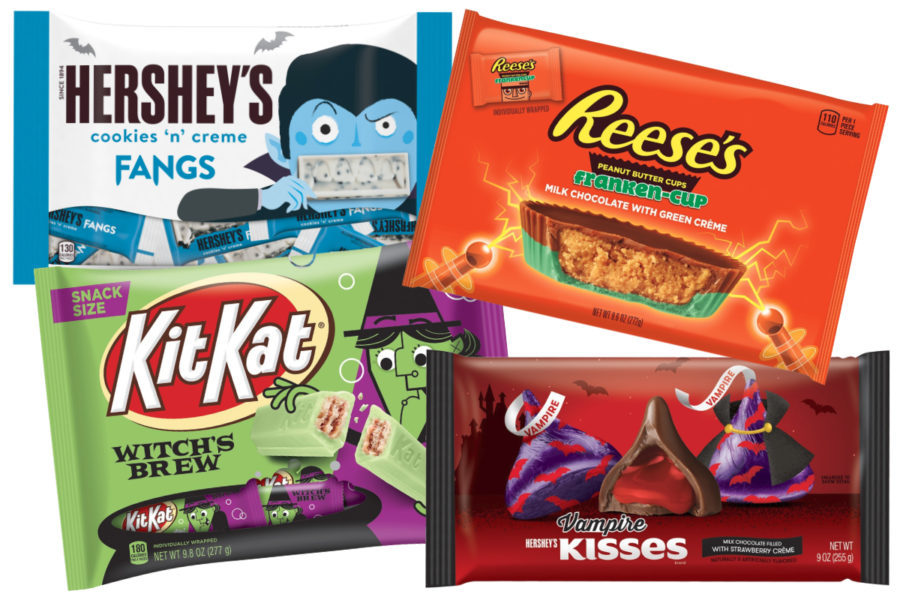HERSHEY, PA. — While the pandemic negatively affected chocolate and candy demand during the Halloween season, The Hershey Co. grew sales over the prior year and significantly expanded its share leadership, said Michele G. Buck, president and chief executive officer. The payoff to Hershey’s strategic insights and execution around the season strengthens management’s confidence heading into the holidays.
“Our decision to lean into Halloween ahead of the season supported consumers' desires to find new and creative ways to celebrate safely,” Ms. Buck said during a pre-recorded discussion of third-quarter financial results on Nov. 6. “Our team, advantaged brands, capabilities and execution enabled us to deliver Halloween net sales slightly above prior year and estimated category seasonal share gains of over 400 basis points.”
Net income attributable to the Hershey Co. in the third quarter ended Sept. 27 totaled $447.3 million, equal to $2.21 per share on the common stock, up 39% from $325.3 million, or $1.59 per share, in the prior-year period. The results included a higher derivative mark-to-market commodity gain and lower selling, marketing and administrative expenses in the current period.
Net sales of $2.2 billion were up 4% from $2.1 billion.
“Our core US business remains healthy as consumers reach for small treats during the pandemic, and they continue to celebrate the important rituals in their lives,” Ms. Buck said. “We also saw sequential improvement in the areas of our business hit hardest by COVID-19, including our international markets, owned retail locations and foodservice business.”
Hershey’s North America net sales increased 6.3% to $2.01 billion in the quarter, driven by volume growth and price realization.
“Within North America, COVID-19 has had a slight positive impact on overall consumer chocolate and sweets consumption, despite significant shifts in where consumers are shopping and what products they are buying,” Ms. Buck said. “Hershey has been able to significantly outperform the category, with chocolate category share gains of 160 basis points and sweet share gains of 30 basis points since the pandemic began.
“We have focused on the areas of our portfolio that are resonating most with consumers during this pandemic, such as s'mores, candy dish and Twizzlers for movie night and road trips. Importantly, our best-in-class capabilities in sales, supply chain and media, just to name a few, have enabled us to capture this incremental growth by quickly identifying trends, predicting demand spikes, ramping up production, adjusting media copy and targeting and deploying our retail sales team.”
Hershey continued to see strong growth in baking products, including chocolate syrup, cocoa and chips as consumers remain at home. In measured channels, sales of Hershey’s baking products have grown 15% to 20% over the past several months, Ms. Buck said.
The company’s gums and mints business, meanwhile, has experienced declines of 20% to 25%, as the need for breath freshening has lessened as a result of social distancing, she added.
“These trends have sustained for several months, and we expect them to continue until consumer mobility increases and social distancing declines,” Ms. Buck said. “Hershey's results here have been relatively in line with the category. Similarly, the nutrition bar category has declined as the need for on-the-go protein and meal replacement has reduced as consumers spend more time at home cooking.”
The company’s recently acquired One Brands nutrition bar business is performing well relative to the category and has gained market share this year, she added.
“While we expect category trends to remain pressured, we are continuing to invest in the business and innovate” she said. “Our mini bars and plant-based line are performing well and adding incremental distribution and households to the portfolio.”
Within the salty snacks category, the company’s SkinnyPop and Pirate’s Booty brands experienced increased sales and share performance in the quarter, benefiting from added capacity and resolved pandemic-related disruptions within the co-manufacturing network. SkinnyPop retail sales increased 10% in the quarter, and Pirate’s Booty retail sales grew 8.3%, Ms. Buck said, citing data from Information Resources, Inc.
“We expect to finish the year strong ahead of both our operating and strategic plans for this year,” she said.
Hershey’s International and Other segment sales decreased 14% to $205.7 million, driven by reduced sales at the company’s owned retail locations, as well as virus-constrained consumer mobility and economic security. The company noted improved trends across markets in the third quarter versus the second quarter.
“As market conditions continue to evolve around the world, we will continue to evaluate our business operations and make any necessary adjustments to help ensure we have the right strategies to make international a growing and profitable contributor to our company's performance,” Ms. Buck said. “In summary, we expect to deliver adjusted earnings in the top half of our original guidance for the year. While there was an approximate 2-point negative impact on sales, driven by COVID-19 challenges within our International and Other segment, we were able to mitigate these pressures with strengths in our North American segment, prudent cost management and commodity favorability.
“Our core US business is pacing ahead of planned expectations, driven by increased at-home consumption as well as strong instant consumable pricing conversion and innovation. Importantly, we have continued to advance work on the largest priorities that we believe are most critical to achieving our long-term strategies and delivering top-quartile financial performance in the future.”
Hershey’s share price on the New York Stock Exchange closed at $149.40 on Nov. 6, up $4.80, or 3.3%, from the previous close of $144.60.





